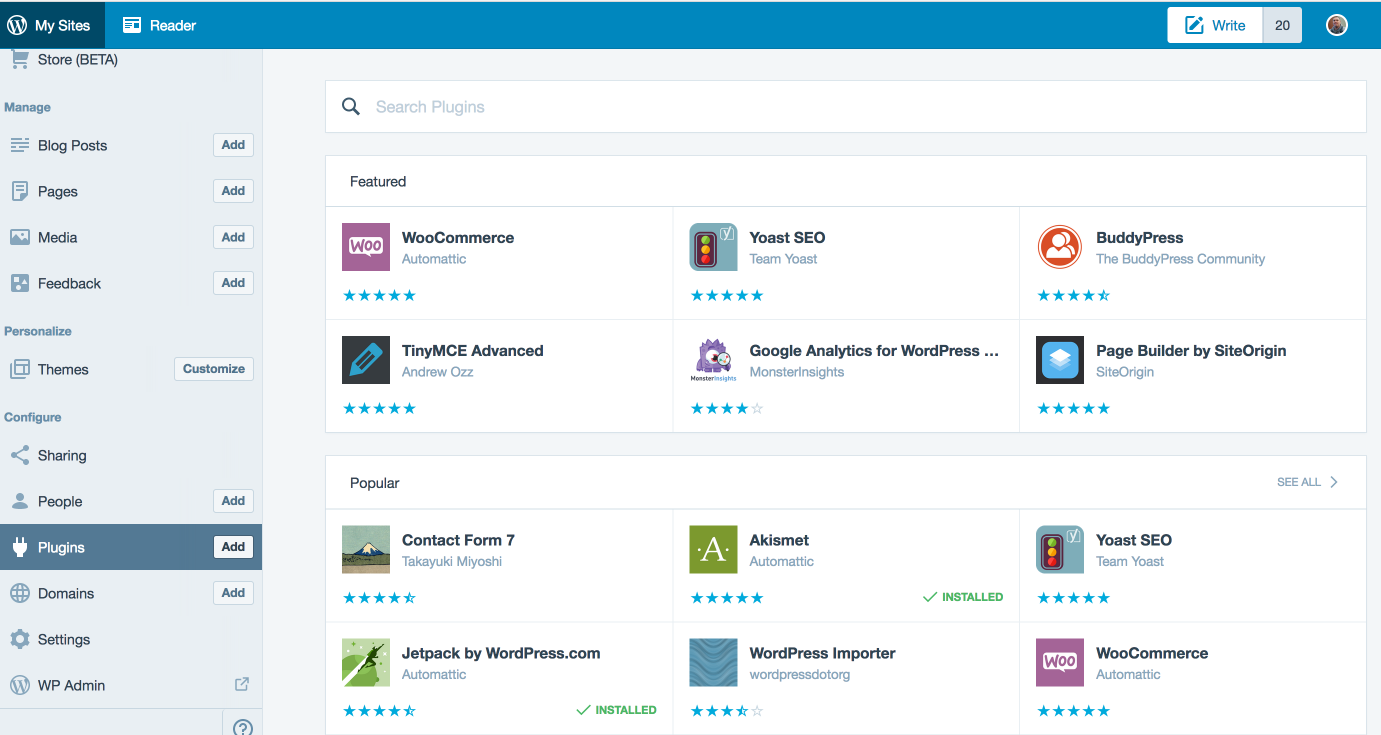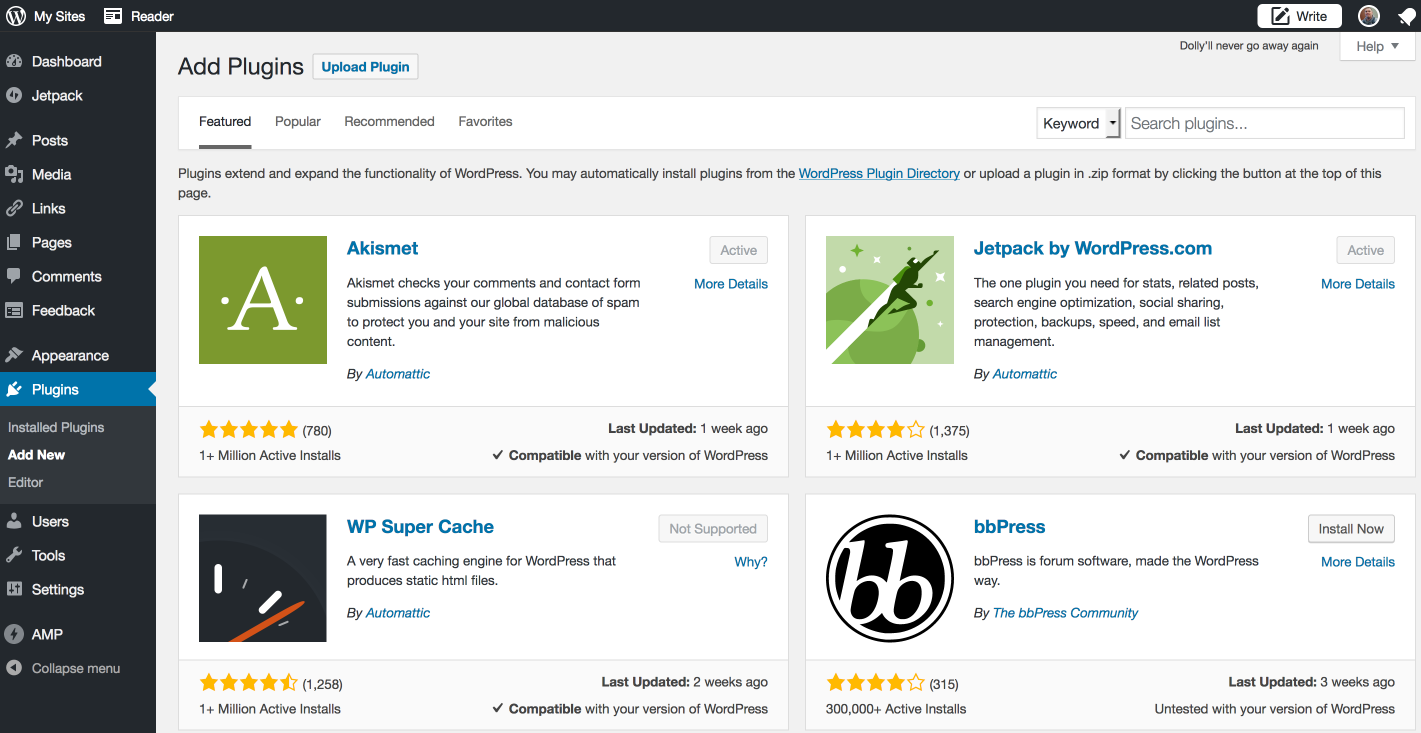Earlier this year, WordPress.com launched an experiment giving Business plan subscribers the ability to install third-party plugins and themes. Automattic concluded the experiment earlier this week and officially made the features part of the subscription plan.
“With support for plugins and third-party themes, WordPress.com Business users will be able to connect their sites to great email and social media tools, e-commerce solutions, publishing and subscription services, and more,” Mark Armstrong said.
This change is twelve years in the making. With the exception of WordPress VIP, customers have not had the ability to install third-party themes and plugins on WordPress.com.
Customers Can Only Install Custom Plugins Through The WP-Admin Interface
Customers can install plugins or themes from the WordPress.org directories or they can upload custom themes and plugins. WordPress.com has two user interfaces, one that resembles Calypso and the other is WP-Admin.
Here is what adding plugins looks like using the Calypso interface. Plugins are displayed from the WordPress.org plugin directory with no way to upload a custom plugin.

This is what adding plugins looks like using the WP-Admin interface. This interface has a button that allows customers to upload a custom plugin. Automattic is aware of the discrepancy and says they’re working on streamlining both interfaces.

Customers Can Upload Non 100% GPL Licensed Code to WordPress.com
The ability to upload a custom theme or plugin truly opens the door for subscribers to customize their sites. But it also allows customers to use themes and plugins that are not 100% GPL licensed. Matt Mullenweg, CEO of Automattic, has made it clear in the past that he will only support plugins and themes that are 100% GPL.
Even though graphics and CSS aren’t required to be GPL legally, the lack thereof is pretty limiting. Can you imagine WordPress without any CSS or JavaScript? So as before, we will only promote and host things on WordPress.org that are 100% GPL or compatible.
Mullenweg has used his influence in the past to provoke marketplaces such as Envato to provide a 100% GPL license option to its authors. Authors who choose not to sell their items with the 100% GPL license are excluded from being able to sponsor or speak at WordCamps.
Although the above quote references WordPress.org, WordPress.com is a platform that Mullenweg controls. It’s odd that the ability to upload a theme or plugin that is not 100% GPL exists on WordPress.com. I believe the feature is an oversight and will be removed in the immediate future ensuring that only themes and plugins from the official directories are allowed to be used.
Managed WordPress Hosts Have Reasons to Be Concerned
Responses to the news from members of the WordPress community are mixed. Phil Crumm, Director of Strategic Opportunities at 10up, published a great article that examines the potential impacts this move will have on the managed WordPress hosting ecosystem and its community:
Within the WordPress community, there’s long been a notion that ‘more users on WordPress’ is universally good. Until now, that’s been difficult to argue: an expansive ecosystem has developed over the last decade, and many now make their living off of WordPress.
Despite that, WordPress.com’s Business Plan now feels like it’s oriented towards cannibalizing users from elsewhere within that ecosystem — from sites that may have ‘grown up’ and moved to another hosting provider to those that now may not know that the broader ecosystem even exists — which is objectively a step backwards for the WordPress community.
Tony Perez, co-founder and CEO of Sucuri, says the implications are gravest to managed WordPress hosts. “The biggest impacts however are likely to be towards those hosting companies that have invested resources (both people and dollars) into creating a vibrant Managed WordPress hosting business ecosystem,” Perez said.
“Long are the days when the market was defined by Page.ly and WPEngine. Today I would consider the space to be saturated, with more flavors of Managed WordPress than ice cream at a Baskin-Robbins.”
Chris Lema, a member of Liquid Web’s Leadership team, responded to the article saying it’s rare for manufactures to enter the same market as their distributors or partners.
“While not impossible, we rarely see manufacturers get into the same business as their distributors or retail partners,” Lema said.
“That’s because it can create a lot of unwanted, unplanned for, unintended secondary consequences. But to inexpensive hosts, this is one of those head-turners, because they were assured, for oh so long, that this wasn’t the game Automattic was getting into.
“But Automattic is not just a nice community player. They’re a business. With investors. And they have to think about their own bottom line. So while it’s not surprising, I think you’re right that hosts have the most to be thinking about.”
Others like Scott Bolinger, have expressed cautious optimism regarding the change.
3rd party plugins and themes can now be used on https://t.co/eNa4NCrrPO. This is great news, although how great remains to be seen. https://t.co/TntfJJ9sLD
— Scott Bolinger (@scottbolinger) August 7, 2017
Some theme and plugin authors see it as a growth opportunity. Josh Pollock, founder of CalderaWP, is excited to see WordPress.com become a quality hosting option for his users.
“As a plugin author, I like not just more places for my plug-in to be used, but more quality hosting options,” Pollock said. “Dealing with sub-optimal environments is the hardest part of being a plug-in author. I’m excited about more users and having those users be on a quality platform.”
How Much Pie Does Automattic Want?
WordPress.com offering a subset of customers the ability to access the incredible third-party WordPress plugin and theme ecosystem is a huge development, but it leaves me with a few questions. First, why is WordPress.com only now offering this feature? Why wasn’t it available years ago?
WordPress.com is now competing head-to-head with managed hosts. As initiatives are established to grow the WordPress pie for all, how much of that pie does Automattic want for itself? Considering Automattic is a business backed by investors, does it matter how much they want or get?
How do you feel about WordPress.com allowing subscribers to tap into the WordPress.org ecosystem?
Now that Automattic has opened up WordPress.com for custom themes and plugins it definitely starts to become a real WordPress hosting company.
If they would have made this move years ago, the WordPress hosting ecosystem probably would be different today. Probably their biggest advantage over the competition is having “WordPress” in their domain name.
Even before they opened up WordPress.com it was already very confusing for users thinking that WordPress.com is “WordPress”, until they realized how many restrictions there are on WordPress.com while learning more about WordPress at the same time and then possibly moving their site to the self-hosted alternative.
But now after WordPress.com has partially opened up (I expect they will open up even more in the future), the lines are becoming really blurry. If you want to start a WordPress site and are looking for a host, which hosting company will you choose as unexperienced user? Hosting companies you’ve never heard about (because it’s your first website) or the WordPress hosting company that is called “WordPress”? Seems the WordPress.com domain name is now really paying off after all.